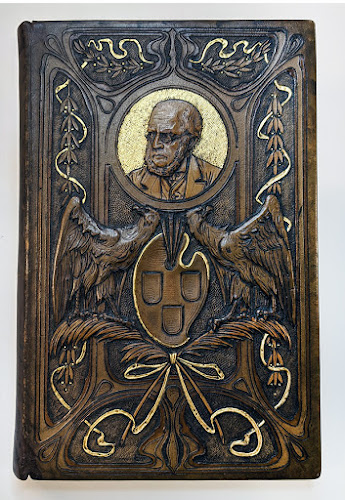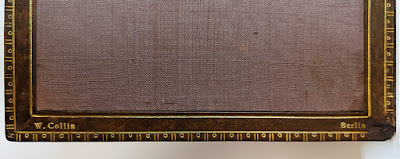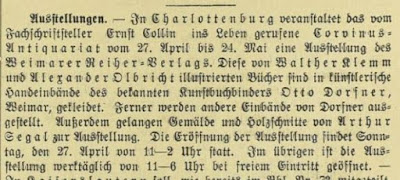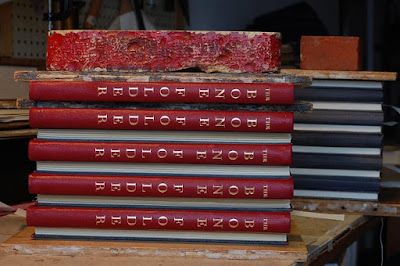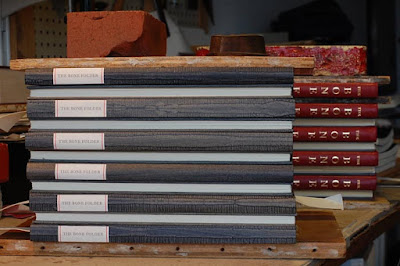Wie in den 6 vergangenen Jahren gebe ich am 31. Mai zum Geburtstag von Ernst Collin (dies wäre sein 132. gewesen) eine Zusammenfassung von Funden und Fortschritten an meinem Projekt über die Collins.
As in the past 6 years, on May 31st, Ernst Collin's birthday (This would have been his 132th) I share updates from my research and findings into his life and work.
Jetzt sind es schon 5 Jahre her seit dieser Blog auf seiner eignen Art lebhaft wurde . Das habe ich Ruth zu verdanken die mich zu Ihrer möglichen Verwandtschaft mit Ernst Collin befragt hat. Dazu kamen meine andauernden offenen Fragen zur Herkunft die in der Einleitung zu ersten Fassung meiner Pressbengel Übersetzung angedeutet wurden. Zusammen genommen mehr als genug Ansporn auf teils obsessiver Weise weiter zu machen. Neues wurde regelmässig auf Facebook unter #Colliniana und #PressbengelProjectBlog geteilt, sowie bei Twitter.
It's been 5 years since this blog "took off" in its own special way. For that we largely have Ruth to thank whose questions about possibly being related to Ernst Collin. Add to that my own nagging open questions from the introduction to the first edition of my translation of his
Pressbengel as
The Bone Folder. Together these ignited an obsessive flame that still burns. Updates have been shared regularly via Facebook under
#Colliniana and
#PressbengelProjectBlog, as well as on
Twitter.
Die Boss Dog Press Ausgabe als Pressendruck ist endlich erschienen und all Vorbestellungen sind verschickt wurden. Das ich erfreut bin ist eine riesige Untertreibung, und daß die Auflage von Don Rash und seiner Boss Dog Presse geschaffen wurde, besonders mit den Photographien von John Hans Schiff, eine riesige Ehre. Es wa eine weiter Weg, aber wie beim guten Wein hat sich das Warten sehr gelohnt. Bis jetzt hat das Buch ein Heim in den Bibliotheken von Azuza Pacific University, Cambridge University, dem Grolier Club und
Yale University gefunden, sowie der Deutsche Nationalbibliothek und dem Leo Baeck
Institute. Für mehr Infos und zu bestellen bitte die Boss Dog Press besuchen oder links klicken.
The Boss Dog Press edition is out and all preorders have shipped. To say I am pleased is a massive understatement, and having Don Rash and the Boss Dog Press create this edition, especially with the photographs of John (Hans) Schiff was a great honor. It's been a long road, but the wait (like with a good wine) very much worth it. So far, the book has found homes at Azuza Pacific University, Cambridge University, the Grolier Club, and Yale University, in addition to the Deutsche Nationalbibliothek and Leo Baeck Institute. For more information and to order, see the
Boss Dog Press site or click the
link at left.
 |
Deluxe edition (left) and regular edition (right).
Both come with a matching slipcase | Beide mit passenden Schuber geliefert |
 |
Titel mit Facsimile der 1922er Erstausgabe
Title page spread with facsimile of original 1922 edition |
I hatte auch die Freude 2 Exemplare dieser Ausgabe zwecks Ausstellungen zu binden und bin mit den Ergebnissen ganz zufrieden. Eines ist unten zu sehen, mit mehr unter diesem Link, inkl. denen in Lagen zum Downloaden und Binden. Letzere sind schon mehr als 1500 mal heruntergeladen seit ich sie so geteilt habe.
It was also my pleasure to bind two copies, ostensibly for exhibitions. I'm rather pleased by how they turned out. One is below, and you can
see more here, including test bindings on the downloadable edition for binding. The latter has been accessed over 1500 times since first appearing online.
 |
| Quarter salmon parchment binding with pastepaper sides (both made by the binder); endpapers of Cave Paper “Alphabet”; graphite top edge; sewn endbands. Décor on boards from images in the text by John (Hans) Schiff with title stamped in gold. Also bound in are an extra set of enlarged photographs and the prospectus. 30.5 x 23.5 x 3 cm. Bound 2017. |
Mehr Schriften von Ernst Collin | More writings by Ernst Collin
Die Bibliographie von Ernst Collins Shriften begann mit 60, wuchs zu 275 als ich meine erste Bibliographie teilte und steht jetzt mit 355 da. Der Großteil der neuen stammt aus der Berliner Volkszeitung wo Ernst in der Redaktion und als Kunstkritiker tätig war. Die Aufsätze wurden über die voll-text Suchen bei Europeana Newspapers und ZEFYS gefunden. Da die OCR mit den Schrifttypen der Zeit oft Probleme hat bin ich mir sicher, daß noch mehr zu finden ist. Ich fand auch einen Zitat zu einem zweisprachigen Aufsatz über die Graphik in der pharma werbe Branche. Das der Aufsatz zweisprachig war, war eine Überraschung. Ich fand auch einige andere Aufsätze in mir noch nicht bekannten Zeitschriften.
The bibliography of titles that started with some 60, grew to 275 when I shared the bibliography, now stands at 355. The bulk of those new additions are from the
Berliner Volkszeitung, where Ernst was an editor and art critic. The articles were found using a full-text search at
Europeana Newspapers and
ZEFYS. Based on the overall quality of the OCR of text from that period, I'm sure there are more within the pages. Also found via a citation in a dissertation was a bi-lingual (Deutsch/English) article on
graphic design in pharmaceutical advertising. The bi-lingual nature was a surprise to me. There were also other articles in unknown-to-me publications.
Die Heftlade und ein Exlibris
Ich konnte mir auch ein zusätzliches Exemplar der Heftlade zulegen, eine Zeitschrift die Ernst Collin 1922-24 für den Jakob-Krause-Bund herausgab. Der Hauptgrund für dieses zusätzliche Exemplar war, daß es alle Beilagen UND die letzten zwei Hefte von 1924 mitgebunden hatte. Die Heftlade erschien nicht 1923.Unter den Beilagen war auch eine zu dem Aufsatz über das Sammeln von Exlibris, eine großes Sammelgebiet einst und und für manche noch jetzt. Die Heftlade hatte eine Auflage von 400 Exemplaren, und es war gut möglich, daß es verschiedene Beilagen zu den einzelnen Aufsätzen gab. In meinem Exemplar war ein Exlibris von Walter Kampmann für... Ernst Collin datiert Dezember 1920.
The Heftlade & an exlibris
I also acquired an additional copy of
Die Heftlade, the "modest" bookbinding journal published 1922-24 by Ernst Collin for the Jakob-Krause-Bund. Reason for trading-up was that this copy had all inserts and the remaining two issues from 1924. The
Heftlade did not appear in 1923. Among the inserts was one to accompany an article on collecting exlibris/bookplates by Ernst. Collecting these was big, still is to some today. The
Heftlade was printed in a run of 400, and may have had several different pasted on samples spread across the edition. Well in my copy there was an exlibris by
Walter Kampmann for none other than... Ernst Collin. The exlibris was created in December of 1920.
Mehr Exlibris von Kampmann gibt es hier zu sehen. Ich habe auch ein reizvolles Exlibris von Ernst Heigenmoser, daß ich 2013 hier teilte. Seit ich das Exlibris für Ernst fand habe ich es oft mit dem Kopf des Herren (rechts) verglichen aus Collins Aufsatz "Bucheinbände aus Fischhaut" (1934).
More exlibris by Kampmann can be seen
here. I also have a charming post-war exlibris by Ernst Heigenmoser that I
shared here in 2013. Since I received the exlibris for Ernst, I've been comparing the head in that wonderful print to the back of the head of the "man in black" at top left in Ernst's article (1934) on
making leather from fish.
 |
| Ernst Collin rechts? | Ernst Collin at right? |
Stolpersteine
Ich sah, daß der 20. März Stolperstein Putztag in Deutschland war, der Tag an dem Menschen versuchen die vielen kleinen individuelle Mahnmale an die von den Nationalsozialisten ermordeten und verfolgten zu reinigen. Als ich den Aufruf auf Twitter sah äußerte ich die Hoffnung, daß vielleicht einer die für Ernst und Else Collin reinigen könnte. Ich bin dieser Person sehr dankbar. Obwohl meine Tochter sie im letzten Sommer versuchte zu reinigen entwickelte sich wieder eine starke Patina. Es ist sehr schön beide wieder in altem Glanz zu sehen. Danke.
I saw that March 20 was the big spring Stolperstein cleaning day in Germany, when
people make a concerted effort to try to clean the many Stolpersteine
for those murdered, or otherwise persecuted by the Nazis. When I saw the
notice on Twitter, I asked that if someone happened to come down past
Cicerostr 61 in Berlin, could they please clean
the stones for Ernst and Else Collin, too. I am very grateful to a kind person for doing this. Even though my daughter had cleaned them last summer they had developed a
strong patina again. Nice to see them (and all the stones) shine. Thank
you.
 |
Here they are before and after cleaning today: pic.twitter.com/QTgau9i8c0 — Jane Yager (@Jane_Yager) March 20, 2018 |
W. Collin
Im letzten Jahr konnte ich auch einiges zu W. Collin finden, besonders die Stelleninserate in der
Berliner Volkszeitung. Dabei waren viele in denen Mädchen und Frauen gesucht wurden um bei der
allgemein und bei der
Kriegsproduktion zu arbeiten.
I was also able to find some great materials about W. Collin that give a sense of the kind of work they hired for while looking in the Berliner Volkszeitung. Among them were ads directed at women seeking labor for
war production, as well as other
general positions.
Ich konnte auch einige Exemplare der Arbeiten von W. Collin erwerben. Unter denen ein Pergament Einband an Goethe's Clavigo und eine kleine Mappe mit interessanten Eigenschaften.
I also acquired two more W. Collin exemplars, one a full vellum binding on
Goethe's Clavigo and the other a
small portfolio that has some interesting properties.
 |
| Clavigo |
 |
| Kleine Mappe | Small portfolio |
Und so kommt zu meiner Sammlung mit einem echten Pressbengel...
And so, to my collection of a genuine pressbengel, ...
dieses schöne Gemälde von einem Falzbein (Bone Folder) von Don Rash.
(Gemalt ist es auf eine der Pappen die seine Werksbank beschützt haben. Werkstoffe als Metapher...)
I now add this wonderful painting by Don Rash of a bonefolder.
(It is painted on a used piece of binders board that once protected the tops of his benches. Material as metaphor...)
Danke Don! | Thank you Don!











